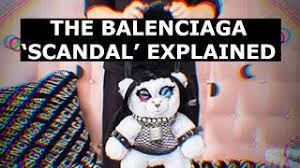In the glamorous world of high fashion, where creativity meets commerce, scandals are often overshadowed by the allure of luxurious designs and runway spectacles. However, every now and then, a scandal emerges that shakes the very foundation of a renowned fashion house. One such controversy that sent shockwaves through the industry was the Balenciaga scandal. Let’s delve into the intricacies of this scandal that tarnished the reputation of a fashion giant.
Table of Contents
ToggleThe Rise of Balenciaga:
Before we unravel the scandal, it’s essential to understand the prominence of Balenciaga in the fashion realm. Founded by Spanish couturier Cristóbal Balenciaga in 1919, the luxury fashion house quickly rose to fame for its avant-garde designs and innovative craftsmanship. Over the years, Balenciaga became synonymous with high-end, cutting-edge fashion, attracting a loyal clientele of celebrities, fashionistas, and socialites.
The Creative Genius of Demna Gvasalia:
In 2015, Balenciaga underwent a significant transformation with the appointment of Georgian designer Demna Gvasalia as the creative director. Gvasalia, previously associated with Vetements, brought a fresh and daring perspective to Balenciaga’s aesthetic, blending streetwear influences with high fashion sensibilities. His approach was disruptive, pushing boundaries and challenging the traditional norms of luxury fashion.
The Triple S Sneaker Phenomenon:
One of the defining moments of Gvasalia’s tenure at Balenciaga was the release of the Triple S sneaker in 2017. The chunky, oversized sneaker quickly became a streetwear icon, embraced by fashion enthusiasts and celebrities alike. However, its exorbitant price tag raised eyebrows, with critics questioning the ethics of charging such a high amount for what essentially seemed like a norm-defying sneaker.
Accusations of Copycat Designs:
As Balenciaga continued to dominate headlines with its unconventional designs, accusations of copycatting began to surface. Several small, independent designers claimed that their original creations were blatantly copied by Balenciaga without proper credit or compensation. Social media became a battleground for these allegations, as outraged designers and their supporters called out the fashion house for what they perceived as creative theft.
The Plagiarism Debate:
The plagiarism debate intensified as evidence mounted, with side-by-side comparisons circulating on various platforms. Critics argued that Balenciaga, under Gvasalia’s leadership, had crossed ethical boundaries by appropriating the work of emerging designers. The controversy ignited discussions about the fine line between inspiration and plagiarism in the fashion industry, prompting a reevaluation of intellectual property rights within the creative realm.
Gvasalia’s Response:
In the midst of the growing scandal, Gvasalia addressed the allegations in a carefully crafted statement. He defended Balenciaga’s design process, emphasizing the importance of inspiration in the fashion industry. Gvasalia argued that creative ideas often circulated freely, and unintentional similarities were inevitable. However, he pledged to investigate the claims seriously and collaborate with affected designers to find an amicable resolution.
Impact on Balenciaga’s Reputation:
The scandal cast a shadow over Balenciaga’s reputation as a visionary and trendsetting fashion house. While some loyalists defended Gvasalia, citing the inevitable overlaps in the world of fashion, others expressed disappointment and disillusionment. The controversy underscored the broader issue of accountability in the industry and the power dynamics between established luxury brands and emerging talents.
Industry Reflection and Calls for Change:
The Balenciaga scandal prompted the fashion industry to engage in introspection. Designers, influencers, and consumers alike began questioning the prevailing culture of appropriation and exploitation. Calls for greater transparency, ethical practices, and fair compensation for designers gained momentum. The scandal served as a catalyst for change, inspiring a collective effort to redefine the norms governing creativity and innovation in fashion.
Balenciaga’s Pledge to Change:
In response to the outcry and in an effort to salvage its tarnished image, Balenciaga announced a series of measures aimed at addressing the concerns raised during the scandal. The fashion house pledged to establish a more robust vetting process for design concepts, ensuring that each creation underwent thorough scrutiny to avoid unintentional resemblances to existing designs.
Collaboration with Emerging Designers:
To rebuild trust within the creative community, Balenciaga initiated collaborations with some of the affected emerging designers. These partnerships were not only a gesture of goodwill but also an opportunity for the fashion house to showcase a commitment to supporting and uplifting rising talents. The collaborations brought a fresh perspective to Balenciaga’s collections and allowed the brand to reconnect with its audience.
The Lasting Impact:
As the dust settled on the Balenciaga scandal, the fashion industry emerged with a heightened awareness of the ethical responsibilities inherent in the creative process. The episode prompted a reevaluation of the industry’s approach to inspiration, originality, and fair practices. Balenciaga, while weathering a storm of criticism, also demonstrated its adaptability and willingness to evolve, setting an example for other fashion houses navigating similar challenges.
Conclusion:
The Balenciaga scandal, though a dark chapter in the brand’s history, catalyzed significant changes within the fashion industry. It forced designers, consumers, and industry insiders to confront the complexities of creativity, intellectual property, and accountability. As the fashion world continues to evolve, the lessons learned from the Balenciaga scandal serve as a reminder of the delicate balance between innovation and ethics, shaping a more conscientious and responsible future for the high-stakes world of luxury fashion.



